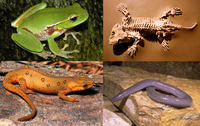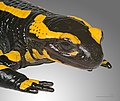User:The Transhumanist/Sandbox144
Introduction
Selected amphibian type
Salamanders are a group of amphibians typically characterized by their lizard-like appearance, with slender bodies, blunt snouts, short limbs projecting at right angles to the body, and the presence of a tail in both larvae and adults. All ten extant salamander families are grouped together under the order Urodela from the group Caudata. Urodela is a scientific Latin term based on the Ancient Greek οὐρά δήλη: ourà dēlē "conspicuous tail". Caudata is the Latin for "tailed ones", from cauda: "tail".
Salamander diversity is highest in eastern North America, especially in the Appalachian Mountains; most species are found in the Holarctic realm, with some species present in the Neotropical realm. Salamanders never have more than four toes on their front legs and five on their rear legs, but some species have fewer digits and others lack hind limbs. Their permeable skin usually makes them reliant on habitats in or near water or other cool, damp places. Some salamander species are fully aquatic throughout their lives, some take to the water intermittently, and others are entirely terrestrial as adults.
This group of amphibians is capable of regenerating lost limbs as well as other damaged parts of their bodies. Researchers hope to reverse engineer the regenerative processes for potential human medical applications, such as brain and spinal cord injury treatment or preventing harmful scarring during heart surgery recovery. The remarkable ability of salamanders to regenerate is not just limited to limbs but extends to vital organs such as the heart, jaw, and parts of the spinal cord, showing their uniqueness compared to different types of vertebrates. This ability is most remarkable for occurring without any type of scarring. This has made salamanders an invaluable model organism in scientific research aimed at understanding and achieving regenerative processes for medical advancements in human and animal biology. (Full article...)
Selected frog article
The Ranoidea are a superfamily of frogs in the order Anura. Members of this superfamily are characterised by having the pectoral girdle fused into a single complex unit, having no ribs, and using an axillary grip during amplexus. The larvae have a single spiracle on the left side and complex mouthparts, or in some species, undergo direct development. The taxonomy of these families has been under heavy debate for many years. In recent studies, molecular data has been used to better identify the phylogentic relationships of these frogs, rearranging and introducing new subfamilies to better distinguish between large groups of frogs (Glaw, Vences, 2001).
The Rainodea superfamily is a large group of frogs from the anura order, with 17 subfamilies. Some of these subfamilies are made up of over 300+ species. Most of the frogs belonging to this group are listed under the least concern section of the IUCN red list. However, there is a significant percentage of these frogs listed as data deficient, endangered, or critically endangered. Like most other amphibians, the frogs listed in this group can be particularly vulnerable to environmental change. Some of the largest threats to the frogs in this group include housing and urban development, farming, illegal trade, mining, etc.
. (See figure 1). (Full article...)
Selected salamander article
Sirenidae, the sirens, are a family of neotenic aquatic salamanders. Family members have very small fore limbs and lack hind limbs altogether. In one species, the skeleton in their fore limbs is made of only cartilage. In contrast to most other salamanders, they have external gills bunched together on the neck in both larval and adult states. Sirens are found only in the Southeastern United States and northern Mexico.
Although they are primarily carnivorous, they are the only salamanders observed eating plant material. (Full article...)
The page "User:The Transhumanist/Sandbox144/box-header" does not exist. The page "User:The Transhumanist/Sandbox144/DYK/3" does not exist.
Picture slideshow
Selected toad article

The neural basis of prey detection, recognition, and orientation was studied in depth by Jörg-Peter Ewert in a series of experiments that made the toad visual system a model system in neuroethology (neural basis of natural behavior). He began by observing the natural prey catching behavior of the common European toad (Bufo bufo).
Ewert's work with toads yielded several important discoveries (Ewert 1974, 2004). In general, his research revealed the specific neural circuits for recognition of complex visual stimuli. Specifically, he identified two main regions of the brain, the tectum and the thalamic-pretectal region, that were responsible for discriminating prey from non-prey and revealed the neural pathways that connected them. Furthermore, he found that the neural mechanisms are plastic and adaptable to varying environments and conditions (Carew 2000; Zupanc 2004). (Full article...)
Selected caecilian article
Typhlonectes (from Greek: τῠφλός tuphlós, 'blind' and Greek: νηκτῆς nēktês, 'swimmer') is a genus of caecilians in the family Typhlonectidae. These fully aquatic amphibians are found in the Amazon Basin and Northern South America, and typically range between 30 and 60 cm (12–24 in) in length.
The genus contains two species:
Categories
Topics
Related portals
Associated Wikimedia
The following Wikimedia Foundation sister projects provide more on this subject:
-
Commons
Free media repository -
Wikibooks
Free textbooks and manuals -
Wikidata
Free knowledge base -
Wikinews
Free-content news -
Wikiquote
Collection of quotations -
Wikisource
Free-content library -
Wikiversity
Free learning tools -
Wiktionary
Dictionary and thesaurus


























































